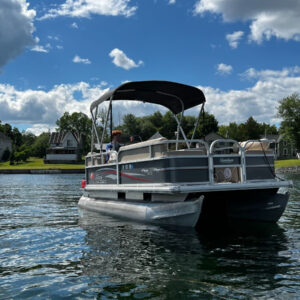Throughout human history, ships have been instrumental in shaping civilizations, exploring uncharted territories, enabling trade, and even changing the course of wars. From ancient vessels that crossed vast oceans to modern ships that redefined engineering limits, many have earned a legendary status. In this blog, we will delve into the stories of some of the most famous ships ever built—vessels that left a lasting impact on history, science, and culture.
Table of Contents
Toggle1. RMS Titanic (1912)
Perhaps the most famous ship of all time, the RMS Titanic was a British passenger liner operated by the White Star Line. Touted as the “unsinkable ship,” Titanic tragically struck an iceberg on its maiden voyage from Southampton to New York City and sank in the North Atlantic Ocean on April 15, 1912. Over 1,500 people perished, making it one of the deadliest commercial peacetime maritime disasters.
The Titanic’s story has fascinated people for over a century, inspiring books, films, and countless documentaries. It became a symbol of human ambition, engineering marvel, and the limitations of technology against nature.
2. USS Enterprise (CV-6)
The name “Enterprise” has been used by multiple ships, but the USS Enterprise (CV-6) of World War II fame stands out. Nicknamed “The Big E,” she was one of the most decorated US Navy ships of WWII. Commissioned in 1938, the aircraft carrier took part in key battles like Midway, Guadalcanal, and the Philippine Sea.
She was instrumental in turning the tide of the war in the Pacific against the Japanese Empire. The USS Enterprise earned 20 battle stars, more than any other U.S. warship in World War II.
3. HMS Victory (1765)
Launched in 1765, the HMS Victory is best known as the flagship of Admiral Horatio Nelson during the Battle of Trafalgar in 1805. The ship played a crucial role in defeating the combined fleets of France and Spain during the Napoleonic Wars.
Nelson died during the battle but secured a decisive victory that confirmed Britain’s naval supremacy. The HMS Victory is preserved today in Portsmouth, UK, and serves as a museum ship—a powerful symbol of British naval heritage.
4. Santa María (1492)
The Santa María was one of three ships used by Christopher Columbus on his first voyage across the Atlantic in 1492. Alongside the Pinta and the Niña, Santa María helped discover the New World, marking the beginning of European exploration and colonization of the Americas.
Although it ran aground off the coast of present-day Haiti, the ship’s legacy continues as a cornerstone of one of history’s most significant voyages.
5. Mayflower (1620)
The Mayflower carried the Pilgrims from England to the New World in 1620. These settlers established the Plymouth Colony in present-day Massachusetts, playing a vital role in early American history.
The ship is a symbol of courage, religious freedom, and the pioneering spirit. The Mayflower Compact, a document signed aboard the ship, became an early framework for democratic governance in the New World.
6. Bismarck (1939)
The Bismarck was the pride of Nazi Germany’s Kriegsmarine and one of the largest battleships ever built by a European power. Commissioned in 1940, the ship struck fear into the British Royal Navy. In its first major operation in May 1941, the Bismarck sank HMS Hood, a significant loss for Britain.
However, after a dramatic chase across the North Atlantic, British forces sunk the Bismarck. Its short but impactful service captured the attention of naval historians and military analysts alike.
7. HMS Beagle (1820)
While the HMS Beagle itself may not have seen massive battles, its scientific significance is immeasurable. This British Royal Navy ship is best known for carrying Charles Darwin on his voyage from 1831 to 1836.
Darwin’s observations made during the voyage, particularly in the Galápagos Islands, laid the groundwork for his revolutionary theory of evolution by natural selection. The HMS Beagle stands as a symbol of scientific exploration and progress.
8. Queen Mary (1936)
The RMS Queen Mary was a luxurious British ocean liner that sailed primarily on the North Atlantic route between Southampton and New York City. Launched in 1936, she served as a troopship during World War II and was later restored to passenger service.
Today, the Queen Mary is a hotel and museum in Long Beach, California, attracting thousands of visitors annually. Her Art Deco design, speed, and luxury made her a favorite among transatlantic travelers in the 20th century.
9. Argo (Mythological)
Though not a historical ship in the conventional sense, the Argo from Greek mythology is one of the most famous fictional vessels. Built for Jason and the Argonauts, the Argo carried them on their quest for the Golden Fleece.
The legend of the Argo highlights ancient seafaring myths and the heroic age of Greek mythology. It has inspired countless literary works, operas, and movies.
10. Vasa (1628)
The Swedish warship Vasa tragically sank on her maiden voyage in 1628, only 1,300 meters from shore. Poor design and miscalculations made the ship top-heavy, causing it to capsize and sink just minutes after launch.
Recovered in 1961, the Vasa is remarkably well-preserved and now rests in the Vasa Museum in Stockholm. It offers a unique glimpse into 17th-century shipbuilding and naval warfare.
Conclusion
These famous ships each have unique stories that span centuries and continents. Some explored unknown lands, others engaged in legendary battles, and a few served as stages for scientific breakthroughs. Whether through triumph or tragedy, these vessels have left a profound mark on the world’s maritime history.
Their legacies remind us of the courage, ambition, and innovation that drive human progress across the oceans. As we continue to explore space and develop futuristic vessels, these legendary ships will always be remembered as symbols of adventure, discovery, and the enduring human spirit.







